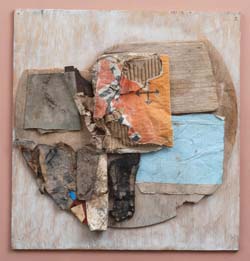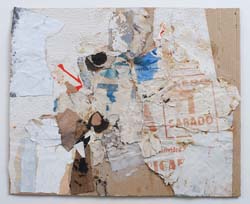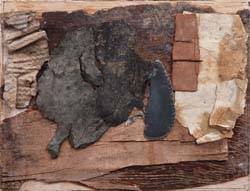HARRY THUBRON
COLLAGES AND CONSTRUCTIONS 1972 -1984
23 March – 27 April 2007 Private View 22 March, 6.30 – 8.30pm
Harry Thubron (1915 – 1985) was a familiar name nationally and internationally during the 50s and 60s. His radical and reconstructive work in art education was legendary and many have said that he was one of the greatest teachers this country has ever known. He was Head of Fine Art at the Art Colleges of Sunderland (1950-55), Leeds (1955-64) and Lancaster (1966-68).
As a painter, sculptor and collagist he is less well known and perhaps his own work as an artist was obscured by his commitment to his teaching practice. When Thubron's involvement with teaching was at its height in the 50s and claiming international attention for his pioneering cross-disciplinary work, his experimental courses and his close association with the 'Basic Design Course', it was difficult for his own work as an artist to take precedence over the range of his professional activities.
There have been exhibitions that have afforded glimpses of Thubron's work but the only survey undertaken was at the Serpentine in 1976 where 70 of his collages and assemblages were exhibited. The last one person show was held, shortly after Thubron died, at Goldsmiths' College in 1986, where he had taught between 1971 and 1982.
This exhibition brings together a number of collages and constructions from the 70s and 80s. It was Thubron's most creative time, when he lived between London and Andalusia. Southern Spain was a place which suited his thinking and provided much of the material for his collages and assemblages. With the help of the village children, he scoured the wide unmade road running past his house, the CAMINO REAL, for cans, wood, metal and paper. In the words of his wife Elma Thubron “these pieces picked up along the old drovers’ road had for him special qualities, vestiges and witness to countless generations of human occupation and the day to day activity of living.” Norbert Lynton describes how in Thubron’s hands these humble materials took on “an unexpected vividness of life and expression;” he put the materials "in relationship with another so that there is an aesthetic marriage in which each participant celebrates the other.” Thubron’s work is an “homage to both very simple and very hidden things”(Martin Shuttleworth).
Although interested in Kurt Schwitters and Antoni Tàpies, it was the work of Paul Klee that Thubron most admired: “no right or wrong techniques or styles, the willingness to let things grow, without prejudice, and the principle that what is used and done should continue to live in the thing made” (Norbert Lynton). Just as Thubron encouraged his students to experiment in a constructive manner, “to exercise their intuition, to explore their own sensibilities”(Jon Thompson), he described his own works as the result of “emotive and imaginative experiences.” His art served as a means of self-development and self-discovery.
Harry Thubron’s work is represented in the collections, among others, of the British Council, the Contemporary Art Society, the Fundacio Calouste Gulbenkian (Lisbon), in the Government Art Collection, the Henry Moore Institute (Leeds) and the Tate Collection (London).
An illustrated catalogue including texts by the cultural historian Jon Thompson and the art historian, critic and curator Norbert Lynton will accompany the show.
For further information please contact Carlotta Graedel Matthäi.
High resolution images are available on request
(t) 020 7242 4443 (e) c.graedel@austindesmond.com (w) www.austindesmond.com
Austin/Desmond Fine Art . Pied Bull Yard . 68-69 Great Russell Street . WC1B 3BN London


